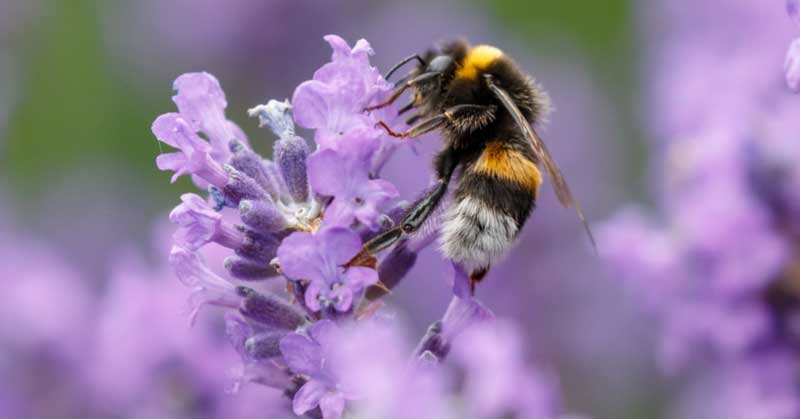Bees are vitally important pollinators of wild plants and agricultural crops around the world. Over the last several years, however, bee populations in North America have been rapidly declining. Some species have lost up to 96 percent of their population in the last twenty years.
Scientists are still not sure exactly what has caused such a significant drop in the number of bees on our continent, however, they speculate that it could be because of a number of factors including pesticides, pathogens, climate change, and potential genetic factors that have destabilized their species [1].
Regardless of the reason, it is crucial that we protect our bee populations. A third of the food we eat worldwide is pollinated by bees, and without them, we will go hungry [2]. One small city in Iowa has been taking significant steps to correct its bee population problem.
Read: Almonds are out. Dairy is a disaster. So what milk should we drink?
The 1,000 Acre Pollinator Initiative
In 2017, the city of Cedar Rapids, Iowa, seeded 188 acres with native prairie grasses and wildflowers, with the eventual plan of creating one thousand acres of space for bees by planting pollinator-friendly foodstuffs [3].
The initiative is being carried out in partnership with the Monarch Research Project (MRP), which works to restore the monarch butterfly population to the area. Cedar Rapids Park Superintendent Daniel Gibbins was the one to initially propose the idea, which planned to create one thousand acres of pollinator habitat over a five-year period.
“With the agricultural boom around 100 years ago, about 99.9 percent of all the native habitat of Iowa has been lost,” said Gibbins. “When you convert it back to what was originally native Iowa, you’re going to help a lot more than just native pollinators. You’re helping birds, amphibians, reptiles, mammals—everything that’s native here relies on native vegetation.” [3]
The city has developed a special mix of grasses and wildflowers to help restore the native habitat, which includes 39 species of wildflowers and seven species of native prairie grasses. The team has cataloged all unused public land where flowers and grasses could be planted, such as corners of parks, golf courses, the local airport, sewage ditches, water retention basins, and roadway right-of-ways.
The initiative addresses the need to restore unproductive lands into healthy habitats for pollinators and other wildlife.
“This initiative uses pollinator habitat restoration to leverage broader environmental health, community aesthetics, recreational opportunities, nature-based educational opportunities, and ultimately human health. The 1,000 Acres Initiative has evolved into an educational effort to build a model public/private partnership, scalable to any size for other communities and agencies to use across the country.” [4]
Excellence in Action Award
The 1,000 Acres project has been going strong since its inception. In 2019, it was the recipient of the Iowa State Association of Counties (ISAC) Excellence in Action Award. In its first three years, just over eight hundred of the one thousand-acre goal has already been installed [5].
Although these areas require less care and attention than manicured lawns, there is some maintenance that needs to be done. Prairie grasses need to be mowed once per year, or burned every three years.
“You can’t just seed them and walk away,” said Gibbins [3].
How You Can Help Save the Bees
You may not be able to plant one thousand acres of bee-friendly territory, but you can still do your part to support a thriving bee population in your community. Even by simply dedicating a small plot in your garden to wildflowers that are native to your area can have an impact.
“When creating pollinator gardens, the most important thing is to have a big diversity of wildflowers and heirloom crops that bloom in the spring, summer, and fall,” says Stephen Buchmann, a pollination ecologist at the University of Arizona [3].
Because they are small, bees often can’t fly very far, so simply planting wildflowers won’t always do the trick. Buchmann recommends that you avoid using pesticides and herbicides on your lawns and gardens, and to provide nesting sites for the bees.
Some species like to nest in the bare, hard ground, while some prefer holes that you can drill into earthen bricks. Others may prefer sandpits or deadwood that have been tunneled through by beetles, but regardless it helps to have mud or water nearby [3].
Building off of Success
The project has already been very successful, and although Gibbins knows it will take time for pollinator populations to establish themselves and begin to thrive, he is confident that this initiative is helping.
“There’s a big push to extend this initiative up to maybe 10,000 acres in Linn County,” he said [3].
The hope is that other communities across the country will be motivated by the success that has been seen in Linn County, and that cities and towns across the country can start to work toward creating better environments for our bee populations to thrive.
Keep Reading: Want to Help Bees? Leave the Dandelions Alone This Spring
- https://data.nal.usda.gov/dataset/data-patterns-widespread-decline-north-american-bumble-bees
- https://www.woodlandtrust.org.uk/blog/2018/07/why-are-bees-important-and-how-you-can-help-them/
- https://www.popsci.com/Cedar-Rapids-Iowa-save-bee-pollinator/?src=SOC&dom=fb&fbclid=IwAR3QoIHMr3tSjcjhTaVCZupY3yDt1Kd-t1eeCzaalTJwnKDhtHn4hkVhpXs
- https://www.linncounty.org/1345/1000-Acres-Pollinator-Initiative
- https://monarchresearch.org/2019/09/09/1000-acres-pollinator-initiative-receives-isacs-excellence-in-action-award/

